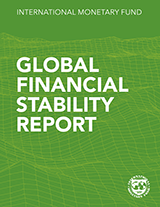
Global Financial Stability Report
Vulnerabilities in a Maturing Credit Cycle
April 2019
The April 2019 Global Financial Stability Report (GFSR) finds that despite significant variability over the past two quarters, financial conditions remain accommodative. As a result, financial vulnerabilities have continued to build in the sovereign, corporate, and nonbank financial sectors in several systemically important countries, leading to elevated medium-term risks. The report attempts to provide a comprehensive assessment of these vulnerabilities while focusing specifically on corporate sector debt in advanced economies, the sovereign–financial sector nexus in the euro area, China’s financial imbalances, volatile portfolio flows to emerging markets, and downside risks to the housing market. These vulnerabilities require action by policymakers, including through the clear communication of any changes in their monetary policy outlook, the deployment and expansion of macroprudential tools, the stepping up of measures to repair public and private sector balance sheets, and the strengthening of emerging market resilience to foreign portfolio outflows.
Report Summary
The April 2019 Global Financial Stability Report (GFSR) finds that despite significant variability over the past two quarters, financial conditions remain accommodative. As a result, financial vulnerabilities have continued to build in the sovereign, corporate, and nonbank financial sectors in several systemically important countries, leading to elevated medium-term risks. The report attempts to provide a comprehensive assessment of these vulnerabilities while focusing specifically on corporate sector debt in advanced economies, the sovereign–financial sector nexus in the euro area, China’s financial imbalances, volatile portfolio flows to emerging markets, and downside risks to the housing market. These vulnerabilities require action by policymakers, including through the clear communication of any changes in their monetary policy outlook, the deployment and expansion of macroprudential tools, the stepping up of measures to repair public and private sector balance sheets, and the strengthening of emerging market resilience to foreign portfolio outflows.
This GFSR also takes an in depth look at house prices at risk, a measure of downside risks to future house price growth—using theory, insights from past analyses, and new statistical techniques applied to 32 advanced and emerging market economies and major cities. The chapter finds that lower house price momentum, overvaluation, excessive credit growth, and tighter financial conditions predict heightened downside risks to house prices up to three years ahead. The measure of house prices at risk helps forecast downside risks to GDP growth and adds to early-warning models for financial crises.
Policymakers can use estimates of house prices at risk to complement other surveillance indicators of housing market vulnerabilities and guide macroprudential policy actions aimed at building buffers and reducing vulnerabilities. Downside risks to house prices could also be relevant for monetary policymakers when forming their views on the downside risks to the economic and inflation outlook. Authorities considering measures to manage capital flows might also find such information useful when a surge in capital inflows increases downside risks to house prices and when other policy options are limited.
Chapter 1: Vulnerabilities in a Maturing Credit Cycle
Full text Summary Online Annex Blog
The April 2019 Global Financial Stability Report (GFSR) finds that despite significant variability over the past two quarters, financial conditions remain accommodative. As a result, financial vulnerabilities have continued to build in the sovereign, corporate, and non bank financial sectors in several systemically important countries, leading to elevated medium-term risks. The report attempts to provide a comprehensive assessment of these vulnerabilities while focusing specifically on corporate sector debt in advanced economies, the sovereign–financial sector nexus in the euro area, China’s financial imbalances, volatile portfolio flows to emerging markets, and downside risks to the housing market. These vulnerabilities require action by policymakers, including through the clear communication of any changes in their monetary policy outlook, the deployment and expansion of macroprudential tools, the stepping up of measures to repair public and private sector balance sheets, and the strengthening of emerging market resilience to foreign portfolio out flows.
Chapter 2: Downside Risks to House Prices
Chapter 2 studies and quantifies house prices at risk, a measure of downside risks to future house price growth—using theory, insights from past analyses, and new statistical techniques applied to 32 advanced and emerging market economies and major cities. The chapter finds that lower house price momentum, overvaluation, excessive credit growth, and tighter financial conditions predict heightened downside risks to house prices up to three years ahead. The measure of house prices at risk helps forecast downside risks to GDP growth and adds to early-warning models for financial crises. Policymakers can use estimates of house prices at risk to complement other surveillance indicators of housing market vulnerabilities and guide macroprudential policy actions aimed at building buffers and reducing vulnerabilities. Downside risks to house prices could also be relevant for monetary policymakers when forming their views on the downside risks to the economic and inflation outlook. Authorities considering measures to manage capital flows might also find such information useful when a surge in capital inflows increases downside risks to house prices and when other policy options are limited.


